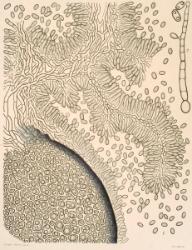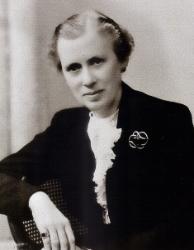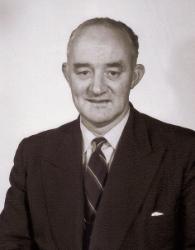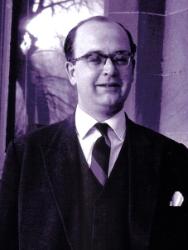Maws & Bairns: Maternal & Child Health in Tayside
Local Heroes
John Chassar Moir (1900-1977)
 Born in Montrose, Chassar Moir became a distinguished professor of obstetrics and gynaecology in Oxford. He led the research in the 1930s that resulted in the discovery and identification of ergometrine, which by preventing and controlling postpartum haemorrhage has saved countless lives. He also achieved distinction for his repair of vesicovaginal fistulae, a distressing condition where urine continually leaks through the vagina. His BMJ obituary described him as “a man who did more than anyone living today to save the lives and relieve the miseries of women”.
Born in Montrose, Chassar Moir became a distinguished professor of obstetrics and gynaecology in Oxford. He led the research in the 1930s that resulted in the discovery and identification of ergometrine, which by preventing and controlling postpartum haemorrhage has saved countless lives. He also achieved distinction for his repair of vesicovaginal fistulae, a distressing condition where urine continually leaks through the vagina. His BMJ obituary described him as “a man who did more than anyone living today to save the lives and relieve the miseries of women”.
It had been known since the 16th century that ergot of rye (a plant disease caused by the fungus Claviceps purpurea) was capable of causing uterine contractions, but was little used in clinical practice due to the unpredictable effects of ergotism. In the early 20th century, it was thought that the alkaloids of ergot, ergotoxine and ergotamine were responsible for the contractions, but Moir showed that this ‘oxytocic effect’ was due to an aqueous extract of ergot, from which he and Harold Dudley later isolated the active principle ergometrine. At a time of financial constraint, Moir was proud that his discovery was accomplished at a total cost of six shillings, attributing this feat to his Scottish inheritance!
The picture on the right shows a botanical teaching chart from the 1890s depicting Ergot (DUNUC 3839/121)
Robert Cochrane Buist (1860-1939)
R C Buist was a Dundonian polymath who, like the founders of the Dundee Social Union, had a keen desire to help the poor and needy of the city. He saw clearly the value of social improvements in the prevention and amelioration of disease, and did his best to bring these about through his office as Chair of the Scottish Council of the British Medical Association.
like the founders of the Dundee Social Union, had a keen desire to help the poor and needy of the city. He saw clearly the value of social improvements in the prevention and amelioration of disease, and did his best to bring these about through his office as Chair of the Scottish Council of the British Medical Association.
As an obstetrician and gynaecologist at Dundee Royal Infirmary for over 20 years, Buist was a pioneer in antenatal care, studying in detail difficult positions of the child in labour and ways of overcoming these. ‘Buist’s pads’ in 1921 were used when baby was lying face forward in order to direct rotation for a safer delivery.
Buist was a strong proponent of a crematorium in Dundee, arguing that land used for cemeteries would be better used for feeding or housing the people. Built in 1936, it arrived in good time for his own cremation three years later.
J S Y Rogers (1868-1949)
J S Y Rogers was a Scot with a broad accent and a powerful personality. He entered general practice in Dundee in 1893 and was appointed assistant physician to Dundee Royal Infirmary (DRI) in 1897. When in 1907 a children’s unit was formed at DRI, Rogers was placed in charge, and the welfare of the young was to become his abiding interest. He recognised the value of DRI’s facilities, but to his mind childhood diseases would never be thoroughly attended to until there was a properly equipped children's hospital, for which he long campaigned.
Rogers was not slow to point the finger at evils that caused so many childhood deaths and illness. Parental unfitness, alcohol, dirty feeding bottles, industrial employment of women, poor clothing, lack of fireguards (serious burns were common), slums and lack of fresh air were some of the issues he highlighted to the British Association on their visit to Dundee in 1912. His article ended with this plea.
Margaret Fairlie (1891-1963)
Known universally to colleagues and students as ‘Madam’, Margaret Fairlie inspired feelings of respect tinged with awe in those around her. A distinguished obstetrician and gynaecologist in Dundee, Angus and North Fife for 37 years, she became the first woman to hold a chair in a Scottish University when appointed Professor of Obstetrics & Gynaecology here in 1940; she was still the only one on her retiral in 1956.
After a visit to the Marie Curie Foundation in Paris, she introduced radium treatment in Tayside, using her own savings to supplement the hospital supply. Her other developments included vaginal smear cytology for cancer diagnosis and punched-card record systems for maternity cases.
James Walker (1916-1995)
James Walker occupied the Chair of Obstetrics & Gynaecology at Dundee  from 1956-81. He was an original pioneer of Feto-Maternal medicine (management of high risk pregnancies), and also pioneered cervical screening in 1962, long before it became a national service in 1988.
from 1956-81. He was an original pioneer of Feto-Maternal medicine (management of high risk pregnancies), and also pioneered cervical screening in 1962, long before it became a national service in 1988.
Walker was interested in medical audit, and built up a database of over 48,000 Dundee hospital birth records between 1952 and 1966. This contains a wealth of meticulously recorded details of pregnancy, labour, birth and care before discharge, although surprisingly no information on whether mothers smoked during pregnancy. 73% of these subjects are identifiable to allow linkage to current databases, making this a unique birth cohort for investigating the foetal origins of adult disease. One study has shown that forceps are not associated with an increase in epilepsy, but are a risk factor for pelvic floor surgery.
 Ross Mitchell (1920-2006)
Ross Mitchell (1920-2006)
Ross Mitchell was appointed as consultant paediatrician in Dundee in 1955, where six years later he became the first UK consultant in neonatal paediatrics, and in 1973 Professor of Child Health. He was a strong proponent for the integration of Community Child Health into Paediatrics and edited the first definitive textbook on that subject. He suggested the motto Hereditas Domini Filii (“Children are a heritage from the Lord” from Psalm 127) for the newly formed Royal College of Paediatrics and Child Health in 1996.
Images courtesy of Royal College of Paediatrics & Child Health and Tayside Medical History Museum